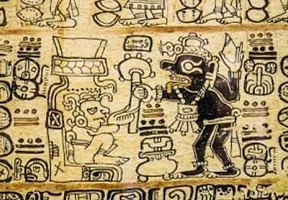By: Daniel Nardini
 The beginnings of modern anthropology (the scientific study of non-western peoples) in what would become Mexico started in the 18th Century, and even then this work was the effort of foreigners outside of Mexico. The first best known researcher of New Spain’s (Mexico’s name during Spanish colonial rule) was an Italian named Lorenzo Boturini Benaducci (1698 to 1749) Born in the Italian peninsula of noble parentage, he was a subject of the Spanish Empire while living in the Holy Roman Empire (Austria). When war broke out between Spain and Austria, Boturini fled to New Spain. During his eight year stay in New Spain, Boturini became fascinated with the native Amerindian peoples throughout the country. He traveled throughout much of the Spanish colony where he collected many artifacts, both from his present day as well as from centuries past of these peoples, and left his collection in the City of New Spain (now Mexico City).
The beginnings of modern anthropology (the scientific study of non-western peoples) in what would become Mexico started in the 18th Century, and even then this work was the effort of foreigners outside of Mexico. The first best known researcher of New Spain’s (Mexico’s name during Spanish colonial rule) was an Italian named Lorenzo Boturini Benaducci (1698 to 1749) Born in the Italian peninsula of noble parentage, he was a subject of the Spanish Empire while living in the Holy Roman Empire (Austria). When war broke out between Spain and Austria, Boturini fled to New Spain. During his eight year stay in New Spain, Boturini became fascinated with the native Amerindian peoples throughout the country. He traveled throughout much of the Spanish colony where he collected many artifacts, both from his present day as well as from centuries past of these peoples, and left his collection in the City of New Spain (now Mexico City).
This collection would eventually become known as the Royal and Pontifical University of Mexico, and was the beginning of anthropology in New Spain. During the Spanish colonial period, there was a growing interest in the study of native peoples in the colony; mostly by European explorers. Boturini wrote a book on the native peoples of New Spain which was published after his death in 1755. The collection Boturini had started grew so much that in 1790 the collection became known as the Cabinet of Curiosities under the Spanish botanist Jose Longinos Martinez. The study of the peoples of New Spain took a back seat to the upheavals of the beginning of the 19th Century. When New Spain became the independent nation of Mexico in 1821, Mexico’s first president, Guadalupe Victoria, established the first true museum of anthropology in Mexico City. Advised by then Mexican historian Lucas Alaman, President Victoria created the National Mexican Museum dedicated to the native peoples of Mexico. This was the beginning of Mexico’s attempt at establishing a national program of studying the peoples of the country; peoples who had been an integral part of the country’s history going back centuries and who distinguished Mexico as a heritage and culture distinct from the former colonial power of Spain.
But this early attempt at trying to study the early indigenous peoples of Mexico was hampered by unstable governments, war, civil war, and invasion from Spain and then France. Another factor was the inherent prejudice in the social hierarchy against the native peoples. Even though successive administrations tried to highlight the unique native cultures of Mexico, the old social attitudes of the ruling elites still saw the native peoples as inferior to the European ways since Spanish colonial times. These attitudes began to slowly change after 1870 when Mexico was finally at peace after the end of the French colonial invasion of the country.








